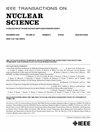基于膨胀脉冲的脉冲膨胀分幅相机动态空间电荷效应研究
IF 1.9
3区 工程技术
Q3 ENGINEERING, ELECTRICAL & ELECTRONIC
引用次数: 0
摘要
膨胀脉冲(DP)是影响磁聚焦脉冲膨胀分幅相机(PDFC)时间性能的关键因素。DP沿光电阴极(PC)传播时,不仅会引起加速电压的变化,还会导致电子脉冲(EP)在不同位置的漂移时间、扩张比和运动半径的不同。这对动态空间电荷效应(SCE)的时空色散(STD)有显著影响。为了解决这个问题,采用了漂移阶跃恢复二极管(DSRDs)来设计DP。通过与EP的动态时空特征建立联系,分析了其对动态SCE的影响。研究结果表明,dsd电路可产生峰值电压为−3.508 ~−1.819 kV、上升次数为236 ~ 288 ps、平均幅值变化率为22.36% ~ 35.0%、斜率变化率为40.07% ~ 62.80%的4个DPs。当特定的DP作用于50mm PC时,SCE在EP漂移过程中的瞬态时间色散(TTD)与电子密度和漂移速度成反比。瞬态空间色散(TSD)受极压半径及其与轴宽之比的显著影响,随两者的增大而减小。在EP漂移过程中,幅度变化率最小和斜率变化率最大的DP将沿PC的平均时间色散(TD)从0.764降低到0.590 ps,将非均匀性从40.69%降低到27.73%。平均空间色散(SD)由21.87降至15.21~\mu $ m,非均匀性由39.94%降至26.13%。这些结果为分析和改善动态SCE的STD和均匀性提供了依据。此外,他们还提供了将高功率脉冲技术集成到超快速诊断应用中的研究见解。本文章由计算机程序翻译,如有差异,请以英文原文为准。
Investigation of Dynamic Space Charge Effects in Pulse-Dilation Framing Camera Utilizing Dilation Pulses
The dilation pulse (DP) is a critical factor influencing the temporal performance of a magnetic focusing pulse-dilation framing camera (PDFC). As the DP propagates along the photocathode (PC), it not only induces variations in acceleration voltage but also results in different drift times, dilated ratios, and motion radii for the electron pulse (EP) at various PC positions. This significantly affects spatiotemporal dispersion (STD) of the dynamic space charge effect (SCE) during the EP drift process. To address the issue, the drift step recovery diodes (DSRDs) are employed to design the DP. By establishing a connection with the dynamic spatiotemporal characteristics of the EP, the impact on the dynamic SCE is analyzed. Research results indicate that the DSRD circuit can generate four DPs with peak voltages ranging from −3.508 to −1.819 kV, rise times between 236 and 288 ps, average amplitude change rates from 22.36% to 35.0%, and slope change rates from 40.07% to 62.80%. When a specific DP is applied to the 50 mm PC, the transient temporal dispersion (TTD) of the SCE during the EP drift process is inversely proportional to the electron density and drift velocity. The transient spatial dispersion (TSD) is significantly influenced by the EP’s radius and its ratio to the axial width, decreasing as both factors increase. When the four DPs are individually applied to the PC, during the EP drift process, the DP with the smallest amplitude change rate and the largest slope change rate reduces the average temporal dispersion (TD) along the PC from 0.764 to 0.590 ps and decreases non-uniformity from 40.69% to 27.73%. The average spatial dispersion (SD) is reduced from 21.87 to $15.21~\mu $ m, and non-uniformity drops from 39.94% to 26.13%. These findings provide the basis for analyzing and improving the STD and uniformity of the dynamic SCE. Additionally, they offer research insights into integrating high-power pulse technology into ultrafast diagnostic applications.
求助全文
通过发布文献求助,成功后即可免费获取论文全文。
去求助
来源期刊

IEEE Transactions on Nuclear Science
工程技术-工程:电子与电气
CiteScore
3.70
自引率
27.80%
发文量
314
审稿时长
6.2 months
期刊介绍:
The IEEE Transactions on Nuclear Science is a publication of the IEEE Nuclear and Plasma Sciences Society. It is viewed as the primary source of technical information in many of the areas it covers. As judged by JCR impact factor, TNS consistently ranks in the top five journals in the category of Nuclear Science & Technology. It has one of the higher immediacy indices, indicating that the information it publishes is viewed as timely, and has a relatively long citation half-life, indicating that the published information also is viewed as valuable for a number of years.
The IEEE Transactions on Nuclear Science is published bimonthly. Its scope includes all aspects of the theory and application of nuclear science and engineering. It focuses on instrumentation for the detection and measurement of ionizing radiation; particle accelerators and their controls; nuclear medicine and its application; effects of radiation on materials, components, and systems; reactor instrumentation and controls; and measurement of radiation in space.
 求助内容:
求助内容: 应助结果提醒方式:
应助结果提醒方式:


